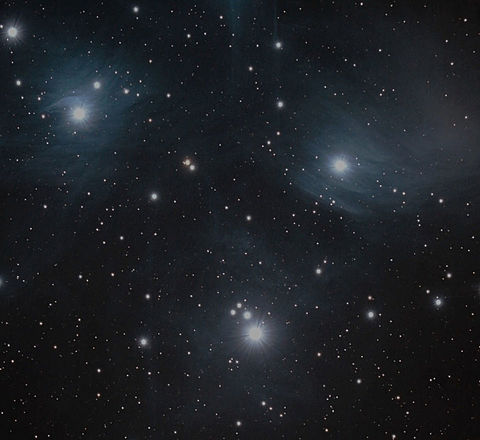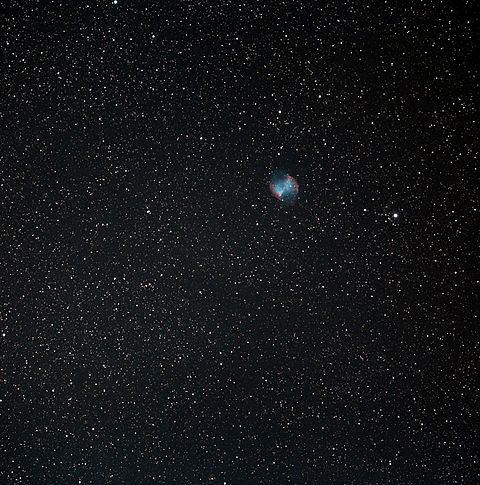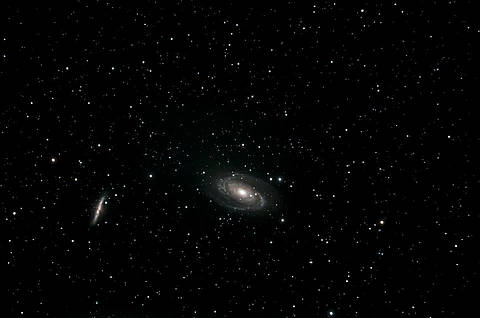Review of the Explore Scientific ED127 FCD 100 Apochromatic Refractor
by Jochen Fehmer
It's all a question of glass, right? In case of the Explore Scientific ED127 FCD 100 the only possible answer is definetly "YES".
Two weeks ago, I received the device including the flattener. Of course, it is completely tested internally before it`s shipped to the Customer.
This time I was very lucky, because the weather forecast promised good weather and on the same night it actually cleared up.

Three of the stars from the seven sisters, the Pleiads. This Foto is greatly magnified to show what the telescope is able to perform. As a follow-up the TDM from Explore Scientific was used. 28 images a 200 secounds with ISO 400 with the Canon EOS 6 D. This night I dont have great conditions. 89% humidity and very bright sky. It`s very amazing how well the telescope can seperate the small stars. The star names are: Alcyone, Maia and Merope.
The Telescope immediately screwed on my mount and was now ready to go. It is obviously very solid, and finished in a very high quality. I especially noticed the Hexafoc™ extract and have already worked with it. I am very enthusiastic about the focuser. It is a 2.5“ pull-out and 1:10 deluxe focuser. The focuser deserves the title DeLuxe, and it works absolutely without restrictions. It is installed on many telescopes from BRESSER and Explore Scientific. It does not tilt, it runs very smoothly and when it is determined?, it remains at the desired point. This is very important for astrophotography.
The technical data of the Explore Scientific ED127FCD100
Diameters of the optics are 127 mm, with a focal length of 952 mm and an opening ratio of 7.5. Perfect dimensions for a perfect result because the optics round off an excellent glass. It is the newly developed Hoya FCD-100 glass. It is supposed to be a glass of maximum colour accuracy and correction. And that`s it! The color purity of the glass sets new standards in this price class. The optical design achieves a polyphase of 0.97, which is a value where one can be sure that the ED127 FCD 100 stands for highest correction. Point shapes, sharp high contrast and colourless illustrations which the owner can count on.
The weight of the Explore Scientific ED127 FCD100 is also terrific. 7.7 kg is photographically easy to handle with many mounts, the length of 80 cm is not too wide and the diameter of the tube of 18 cm represents no problems to balance.
When I first looked through the telescope at M 45 I immediately noticed that it fulfills everything the description promisses. It amazed my astrophotographic heart so much that I spent 1 hour looking into the great sky. I used the 68 degree Series Explore Scientific Eyepiece with 28 mm. For the first time in years, I took the time to „ look“. The stars were sharp to the edge and I couldn´t find a colour error. It was so much fun that I will definitely repeat this. Now the work began, the batteries of the camera were charged and I attached the Canon EOS 6 D by bayonet lock to the ED 127, Laptop connected and APT was started. As a guiding system, I used the TDM from Explore Scientific. This is a unit which reduces the tracking error of the mount enormously to a minimum. This eliminates the need for an additional guiding camera and guide tube, since the TDM automatically corrects all errors of the RA drive. A very precise classification of the mount is absolutely necessary! The little extra work is worth it, once it runs, there is no stopping. Great for fixed mountings.

The Dumbell nebular. 12 images a 3,2 minutes with ISO 400. German mount and Explore Scientific TDM tracking. The dumbell nebular was already quite deep and the sky was even worse. Without a corresponding filter, longer recording are impossibly to manage. Camera was the astromodified Canon EOS 6 D. It is astonishing how clean the TDM tracks.
The first object I chose was the dumbell nebula, Messier 27. It was already quite low in the sky and unfortunately the last nights in the Münsterland, Germany has a high atmospheric humidity. But this beautiful object should be the first photo. Despite the adverse conditions, I was very satisfied with the result. Meanwhile, Messier 45 was high enough and out of the haze. I took 28 Images and I could already see the images super resolution on my laptop. The single appearance of the stars were enormous. This telescope is also a great device for Observatories in case you prefer to observe double stars. After developing the pictures I enlarged a section of the seven sisters to show how clean the optic are.

A look at the past, M 81 and M 82. Distance to my telescope about 11 million light years. Diameter of M81 approx 82.000 light years. Not just around the corner. The weather at night from 29.12.to the 30.12. 2016 was not perfect. High humidity and thus bright skies without corresponding filters made it a gamble. Even the two objects where still not perfectly visible in the sky they motivated me to try it. The Image was exposed with ISO 400 for 6 hours and 23 Minutes. Camera was the Canon Eos 6 D astromodified, tracking TDM from Explore Scientific.
At the end of my first series, I chose M 81 and M 82. The Explore Scientific ED 127 FCD 100 was supposed to capture the two objects for the rest of the night. They were not optimal conditions, not to mention the weather, but I knew everything was save whatever happend on the mount. Over six hours were exposed.
My personal conclusion about the Explore Scientific ED 127 FCD after the first tests:
WOW! Anyone who has used this device once does not want to give it back. It is on one level with a number of considerably more expensive telescopes. Great!

 Deutsch
Deutsch
 English
English
 Francais
Francais
 Español
Español
 Italiano
Italiano
 Nederlands
Nederlands
 Polski
Polski

